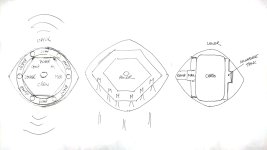MS Paint is adequate, if you're patient and persistent. Very patient, very persistent.
I'm a Mac user ... with a (by now) old 2011 iMac (that was top of the line new when I bought it).
I'm just waiting for the M2 Apple Silicon Mac Mini to arrive before swapping out.
Was wondering what shape you envisaged the Rift Courier.
The
Rift Courier?
The Rift Courier would be a 2 deck high "flying saucer" type of design, albeit with a mid-deck halfway between the 2 decks around the perimeter of the craft.
The bottom deck would have the 60 ton square(-ish) single deck cargo bay in the middle that can be lowered out of the hull for true roll on/roll off cargo loading and unloading. One side would have ramp access up into the cargo bay to access the 5 ton mail vault reserved area that remains inside the hull and does not get lowered with the rest of the cargo bay to the surface for access. While the cargo bay is enclosed in the hull, the cargo ramp running along one side is used for crew access to both the cargo bay (proper) and mail vault, but also the ventral hatch airlock. The far side of the cargo bay away from the access ramp contains the collapsible fuel tank assembly.
Surrounding the square cargo bay would be some of the engineering spaces and fuel as a part of the engineering "mid-deck" halfway between the cargo deck below and the crew deck above for the 2 decks, giving the ship a flatter/wider rounded saucer aspect to it.
The layout of the engineering "mid-deck" outboard of the cargo bay all the way around would be done in an eqilateral hexagonal arrangement with
M-Drive plates and
HEPlaR elements ringing the perimeter of the circular hull. Fuel scoops would be placed in between the 6 maneuver drive elements with power plant, fuel purification and fuel tankage inboard from the maneuver drive.
The crew deck over the cargo bay is also done in an equilateral hexagon arrangement, with the central hub providing access up to the turret mounted dorsally above the hull in the center. The bridge, computer, avionics, ship's locker, dorsal iris airlock and (of course) crew quarters. Surrounding these crew spaces would be a circular ring of engineering space housing the jump bubble projectors mounted on the dorsal surface connecting to the engineering spaces in the engineering "mid-deck" outboard of the crew and cargo spaces halfway between the two decks. The idea being that when maneuvering the ship flies "edge on" through space in a "lateral" fashion, but when jumping it does so by aiming the ventral nadir of the ship at the destination and the jump ring "on top" in effect "pushes" the ship into jump space (so 90º pitch up and "belly flop" to jump).
Any remaining space for all decks is taken up by fuel.
Because of this arrangement, any external cargo that is being towed either through normal space or through jump space will typically be "lashed to the hull" near the edge of the saucer on the dorsal side first between the maneuver drive and jump drive exterior features. If there is more external cargo to be towed than can be safely accommodated on the dorsal side of the ship, additional lashing points can be used on the ventral side. Obviously, external cargo loading will tend to affect the streamlining of the craft (dorsal loads can be somewhat shielded from atmospheric entry, while ventral loads cannot) and in circumstances where streamlining needs to be maintained to "land" such external cargo, the standard procedure would be to "park" the excess external cargo in orbit and run relays to the surface through atmosphere using the internal cargo bay until all of the external cargo has been transferred from orbit to the surface.
That was the basic idea for all of the sub-200 ton "Courier" ship designs. The main variation between all the various designs is in the amount of engineering space devoted to cargo+fuel vs maneuver drive+power plant.




